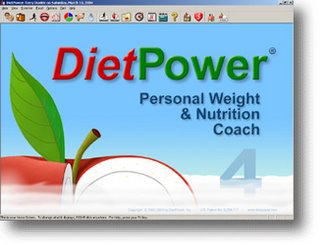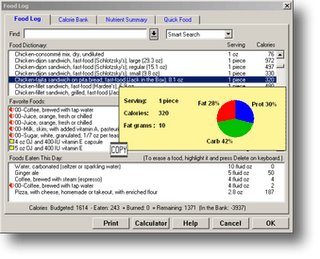Diet Tri-ing
I'm not "tri-ing" to lose weight, but it sure would be a happy by-product. Losing those extra pounds are also a good way of getting faster. Just imagine ditching the 50lb. ballast around your waist and still having all of the endurance and strength of before. This is really just low hanging fruit.
That being said I have never had much success on diets, and I have sure tries a number of them. I lost thirty lbs. on Atkins, but slowly gained it all back when I could no longer live with the severe restriction. I simply can't give up pizza, pasta and bread forever.
It is simply fundamental that to lose weight you have to burn more calories than you eat. All diets work by either raising metabolism or by effectively lowering the number of calories that you eat. You would think that with all the training required for a triathlon you could eat all that you wanted, but it doesn't really work that way. After a long work out, you get really hungry. It is also very possible to eat too little and really starve your muscles of the fuel they really need to perform. What is needed is a way to eat in such a way that accounts for the training and the metabolic changes that happen when you train and consistently have a small calorie deficit.
My solution is DietPower. It essentially is a metabolism calculator. Here is a screen shot of the program.

Each day you enter the food you have eaten, exercise you have done, and your body weight, and it calculates your metabolism. The food is entered through a large menu of preprogrammed food items. The reason I choose DietPower is that it has the largest food dictionary of any program I know of. You can also add you own foods and add “recipes,” which are essentially collections of foods. Here is a screenshot of the food log.

You set a target weight (lose, gain or maintain) and the software gives you a daily calorie target. If you stick relatively close to you target you will reach the goal. It’s almost magic. The software can also track user programmed variables such as body fat percentage, waist size, or whatever you want. Here is a screen shot of someone’s weight history. Since I’m just staring the program again I don’t have a history yet. But just you wait. . .

In addition to calories the software will also track most nutrients. You can see where you are lacking and perhaps what you eat too much of, sugar or sodium, for example. I plan on keeping close track of protein intake since I’m training.

All of this is very useful, but the software is not without its drawbacks. First it can be a pain to enter your food every day. It gets faster once you have been doing it for a while, but it still takes a few minutes every day. You also have to measure everything you eat, or at least have a good idea of how much you are eating. Foods with many ingredients are a pain, because if they are not in the food dictionary, you have to add them one ingredient at a time. For some foods this is just impossible. Because of this the software has a perverse tendency to promote eating pre-portioned food such as frozen and canned foods or fast food, simply because nutrition information is readily available and easy to enter.
I have decided that 240 lbs is a reasonable goal for the end of 20 weeks. Be sure to stay tuned and see how it all works out.
That being said I have never had much success on diets, and I have sure tries a number of them. I lost thirty lbs. on Atkins, but slowly gained it all back when I could no longer live with the severe restriction. I simply can't give up pizza, pasta and bread forever.
It is simply fundamental that to lose weight you have to burn more calories than you eat. All diets work by either raising metabolism or by effectively lowering the number of calories that you eat. You would think that with all the training required for a triathlon you could eat all that you wanted, but it doesn't really work that way. After a long work out, you get really hungry. It is also very possible to eat too little and really starve your muscles of the fuel they really need to perform. What is needed is a way to eat in such a way that accounts for the training and the metabolic changes that happen when you train and consistently have a small calorie deficit.
My solution is DietPower. It essentially is a metabolism calculator. Here is a screen shot of the program.

Each day you enter the food you have eaten, exercise you have done, and your body weight, and it calculates your metabolism. The food is entered through a large menu of preprogrammed food items. The reason I choose DietPower is that it has the largest food dictionary of any program I know of. You can also add you own foods and add “recipes,” which are essentially collections of foods. Here is a screenshot of the food log.

You set a target weight (lose, gain or maintain) and the software gives you a daily calorie target. If you stick relatively close to you target you will reach the goal. It’s almost magic. The software can also track user programmed variables such as body fat percentage, waist size, or whatever you want. Here is a screen shot of someone’s weight history. Since I’m just staring the program again I don’t have a history yet. But just you wait. . .

In addition to calories the software will also track most nutrients. You can see where you are lacking and perhaps what you eat too much of, sugar or sodium, for example. I plan on keeping close track of protein intake since I’m training.

All of this is very useful, but the software is not without its drawbacks. First it can be a pain to enter your food every day. It gets faster once you have been doing it for a while, but it still takes a few minutes every day. You also have to measure everything you eat, or at least have a good idea of how much you are eating. Foods with many ingredients are a pain, because if they are not in the food dictionary, you have to add them one ingredient at a time. For some foods this is just impossible. Because of this the software has a perverse tendency to promote eating pre-portioned food such as frozen and canned foods or fast food, simply because nutrition information is readily available and easy to enter.
I have decided that 240 lbs is a reasonable goal for the end of 20 weeks. Be sure to stay tuned and see how it all works out.



0 Comments:
Post a Comment
<< Home